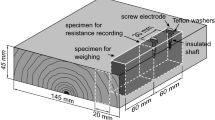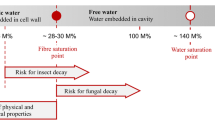Abstract
The wood moisture content influences the service life of wood structures since wood is susceptible to decay by rot fungi if it is exposed to high moisture contents during long periods of time. In rain exposed structures, the moisture content close to end grain surfaces and joints can be significantly higher than the average moisture content, but moisture content determinations at such locations require small moisture content sensors. This paper presents small resistive moisture content sensors fastened by electrically conductive adhesive. The relationship between moisture content and electrical resistance was determined for Norway spruce (Picea abies (L.) Karst.) for a wide range of moisture conditions achieved both by equilibrating specimens over saturated salt solutions and by the pressure plate method. The error, i.e. the difference between the gravimetric moisture content and the moisture content from the regression equation, increased with increasing moisture content. Neither the wood type (heartwood/sapwood) nor the growth rate (southern or northern Sweden) influenced the resistance-moisture content relationship.
Zusammenfassung
Die Holzfeuchte hat einen Einfluss auf die Nutzungsdauer von Holzkonstruktionen, da Holz anfällig für Pilzbefall ist, wenn es über einen längeren Zeitraum hoher Feuchte ausgesetzt ist. Bei Konstruktionen, die Regen ausgesetzt sind, kann der Feuchtegehalt im Hirnholzbereich und im Bereich von Verbindungen deutlich höher als der mittlere Feuchtegehalt sein. Zur Bestimmung des Feuchtegehalts an diesen Stellen sind kleine Feuchtesensoren erforderlich. In diesem Artikel werden kleine widerstandsbasierte Feuchtesensoren vorgestellt, die mit elektrisch leitfähigem Klebstoff befestigt werden. Der Zusammenhang zwischen Feuchtegehalt und elektrischem Widerstand wurde am Fichtenholz (Picea abies (L.) Karst.) in einem weiten Feuchtebereich bestimmt, wobei die Feuchten sowohl durch Lagerung über gesättigten Salzlösungen als auch mittels der Drucktopfmethode eingestellt wurden. Der Fehler, d.h. die Differenz zwischen dem gravimetrischem und dem über die Regressionsgleichung ermittelten Feuchtegehalt nahm mit steigendem Feuchtegehalt zu. Weder die Art des Holzes (Kernholz/Splintholz) noch die Wuchsbedingungen (Süd- oder Nordschweden) hatten einen Einfluss auf die Beziehung zwischen Widerstand und Holzfeuchte.










Similar content being viewed by others
References
Brischke C, Rapp AO, Bayerbach R (2008) Measurement system for long-term recording of wood moisture content with internal conductively glued electrodes. Build Environ 43(10):1566–1574
Brown JH, Davidson RW, Skaar C (1963) Mechanism of electrical conduction in wood. Forest Prod J 13(10):455–459
Christensen GN, Kelsey KE (1959) Die Geschwindigkeit der Wasserdampfsorption durch Holz (The rate of sorption of water vapor by wood). Holz Roh- Werkst 17(5):178–188
Cloutier A, Fortin Y (1991) Moisture-content–water potential relationship of wood from saturated to dry conditions. Wood Sci Technol 25(4):263–280
Dai G, Ahmet K (2001) Long-term monitoring of timber moisture content below the fiber saturation point using wood resistance sensors. Forest Prod J 51(5):52–58
Davidson RW (1958) The effect of temperature on the electrical resistance of wood. Forest Prod J 8(5):160–164
De Groot RC, Highley TL (1995) Forest Products Laboratory methodology for monitoring decay in wood exposed above ground. In: Proceedings of IRG Annual Meeting, 1995. IRG/WP 95-20074
Derbyshire H, Miller ER (1997a) Moisture conditions in coated exterior wood Part 2: the relation between coating permeability and timber moisture content. J Inst Wood Sci 14(4):162–168
Derbyshire H, Miller ER (1997b) Moisture conditions in coated exterior wood Part 3: moisture content during natural weathering. J Inst Wood Sci 14(4):169–174
Du QP, Geissen A, Noack D (1991) Widerstandskennlinien einiger Handelshölzer und ihre Meßbarkeit bei der elektrischen Holzfeuchtemessung. Holz Roh- Werkst 49(7–8):305–311
Forsén H, Tarvainen V (2000) Accuracy and functionality of hand held wood moisture content meters. VTT Publications 420, VTT Building Technology, Espoo
Gaby L, Duff J (1978) Moisture content changes in wood deck and rail components. Forest service research paper SE-190, US Department of Agriculture, Southeastern Forest Experiment Station, Asheville, North Carolina
Greenspan L (1977) Humidity fixed points of binary saturated aqueous solutions. J Res Natl Bureau Stand-Phys Chem 81A(1):89–96
Håkansson H (1998) Retarded sorption in wood. Doctoral thesis, TABK–98/1012, Lund University, Lund
Hjort S (1996) Full-scale method for testing moisture conditions in painted wood panelling. J Coat Technol 68(856):31–39
Hjort S (1997) Moisture balance in painted wood panelling. Doctoral thesis, P-97:5, Chalmers University of Technology, Göteborg
James WL (1988) Electric moisture meters for wood. FPL-GTR-6, United States Department of Agriculture, Forest Service, Forest Products Laboratory Madison
Johansson P (2005) Water absorption in two-layer masonry systems: properties, profiles and predictions. Doctoral thesis, TVBM-1024, Lund University, Lund
Keylwerth R, Noack D (1956) Über den Einfluß höherer Temperaturen auf die elektrische Holzfeuchtigkeitsmessung nach dem Widerstandsprinzip. Holz Roh- Werkst 14(5):162–172
Kumaran MK, Lackey JC, Normandin N, Tariku F, van Reenen D (2002) A thermal and moisture transport property database for common building and insulating materials. Final report from ASHRAE research project 1018-RP, Institute for Research in Construction, National Research Council, Ottawa
Kuroda N, Tsutsumi J (1982) Anisotropic behaviour of electrical conduction in wood. Kyuschu Univ For Rep 28:25–30
Lin RT (1965) A study on the electrical conduction in wood. Forest Prod J 15(11):506–514
Norberg P (1999) Monitoring wood moisture content using the WETCORR method. Part 1: background and theoretical considerations. Holz Roh- Werkst 57(6):448–453
Samuelsson A (1992) Calibration curves for resistance-type moisture meters. Paper presented at the 3rd IUFRO International Wood Drying Conference, Vienna, 18–21 August 1992
Siau JF (1984) Transport processes in wood. Springer, Berlin
Skaar C (1964) Some factors involved in the electrical determination of moisture gradients in wood. Forest Prod J 14(6):239–243
Skaar C (1988) Wood-water relations. Springer, Berlin
Stamm AJ (1927) The electrical resistance of wood as a measure of its moisture content. Ind Eng Chem 19(9):1021–1025
Stamm AJ (1929) The fiber-saturation point of wood as obtained from electrical conductivity measurements. Ind Eng Chem Anal Ed 1(2):94–97
Takechi O, Inose O (1953) Analysis on the fundamental properties of electric resistance of wood II—on the electric resistance of wood in relation to the moisture content and the temperature. Sci Rep Matsuyama Agric College 10(March):13–35
Thygesen LG, Engelund ET, Hoffmeyer P (2010) Water sorption in wood and modified wood at high values of relative humidity. Part I: results for untreated, acetylated, and furfurylated Norway spruce. Holzforschung 64(3):315–323
Venkateswaran A (1972) A note on densities and conductivities of wood. Wood Science 5:60–62
Venkateswaran A (1973) Effect of compression on electrical properties of wood and cellulose. Wood Science 5(3):230–234
Venkateswaran A (1974) The interdependence of the lignin content and electrical properties of wood. Wood Fiber 6(1):46–52
Vermaas HF (1975) A summary of literature references of factors affecting moisture content determination with DC resistance measurements. S Afr For J 95:35–36
Vermaas HF (1983) A note on the possible influence of electrode-pressure on the relationship between DC resistivity and lignin content of wood. J Inst Wood Sci 9(6):268–269
Vermaas HF (1984) The influence of sample density on the DC resistance of wood. Holzforschung 38(2):109–112
Wadsö L (1993) Measurements of water vapour sorption in wood. Part 2. Results. Wood Sci Technol 28(1):59–65
Wadsö L (1994a) Describing non-Fickian water-vapor sorption in wood. J Mater Sci 29(9):2367–2372
Wadsö L (1994b) Unsteady-state water vapour adsorption in wood: an experimental study. Wood Fiber Sci 26(1):36–50
Wadsö L, Svennberg K, Dueck A (2004) An experimentally simple method for measuring sorption isotherms. Drying Technol 22(10):2427–2440
Acknowledgments
Thomas Ulvcrona, Swedish University of Agricultural Sciences, is gratefully acknowledged for providing the wood material used in this study. Thord Lundgren, Division of Structural Mechanics, Lund University is gratefully acknowledged for building the logger. This work is part of WoodBuild, a research programme within the Sectoral R&D Programme 2006–2012 for the Swedish forest-based industry. This Programme is jointly funded by the government, industry and other stakeholders with interests related to the Swedish forest-based industry.
Author information
Authors and Affiliations
Corresponding author
Rights and permissions
About this article
Cite this article
Fredriksson, M., Wadsö, L. & Johansson, P. Small resistive wood moisture sensors: a method for moisture content determination in wood structures. Eur. J. Wood Prod. 71, 515–524 (2013). https://doi.org/10.1007/s00107-013-0709-0
Received:
Published:
Issue Date:
DOI: https://doi.org/10.1007/s00107-013-0709-0




